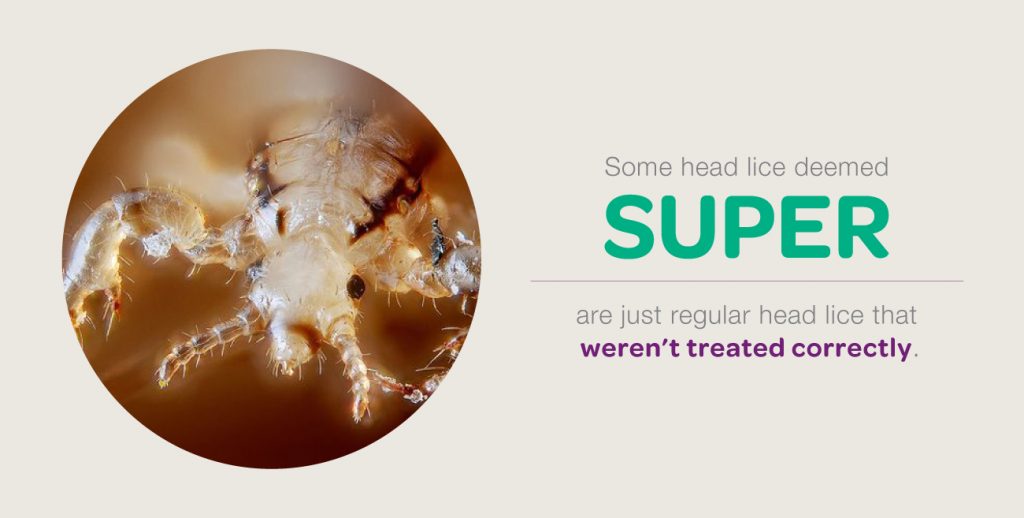Invasion of the Super Lice

Back to school season means bus rides and backpacks, library and lunch, report cards and reading, homework and head lice. Yes, those wingless, sesame seed-sized insects are back. They’re contagious, annoying, and celebrate the end of summer break.
If that weren’t enough, recent research also shows a number of head lice are now resistant to pyrethrins – the main ingredient in popular over-the-counter medications such as Nix and Rid.
Some call them “super lice.” Others call them “indestructible.”
And parents across the nation are asking the same question: How do we get rid of them?
Head Lice and School
Head lice are strictly a human problem. We are their only known host. They spend their entire lives on our scalps and feed exclusively on human blood.
Thankfully, they do not carry diseases and cause more itching, annoyance, and cosmetic worry than actual medical risk.
As difficult as getting rid of head lice can be, they’re not the most able creature in the animal kingdom. They can’t fly, swim, jump, run or even walk effectively on flat surfaces. They’re super power is unexciting – clinging. When head lice find a strand of human hair, they hang on for dear life. Failing to do so would be dire for the lice. They can’t live for more than a few days without a host.
Head lice are more common in children because a child’s fine hair is easier to grasp. Which brings us to school. All those kids, in one place, with heads in close proximity, makes it easier for opportunistic head lice to travel from one tiny head to another.
How’d They Get So Super?
The phrase “super lice” conjures images of a creepy-crawly, horror movie antagonist with giant fangs and size and strength exponentially greater than regular head lice. Tap the brakes on that nightmare. Super lice are no bigger, stronger, uglier or more dangerous than regular head lice.
So what separates super lice from ordinary head lice?
Evolution. Some lice have simply developed a resistance to the chemicals we’ve spent decades using to fight them. This concept is not uncommon in nature. It’s no different than bacteria becoming resistant to antibiotics. It’s the reason we develop new flu vaccines each year.
Living things have preservation in mind, whether they know it or not.

Fighting Super Lice
Despite this new wrinkle, treatment for head lice still doesn’t differ much from yesteryear. Start by thoroughly examining your child’s head and removing all lice and nits – head lice eggs – using a nit comb, typically packaged in a kit with an over-the-counter medication.
Now you know where the term “nitpicking” comes from …
Then apply the medication paying special attention to the directions. Many treatments involve a second application a week after the first. Fight the urge to do the follow-up treatment early. While a double-dose might seem like a surefire way to deliver a knockout blow, the timing is rooted in science. The second application is designed to kill any newly-hatched lice that were eggs the first time around.
And don’t be late with your follow-up treatment. You’ll want to catch the newly-hatched lice before they continue the cycle by laying eggs of their own.
The importance of sticking to the directions cannot be overstated. Some head lice deemed “super” are just regular head lice that weren’t treated correctly.
Soak your nit combs in scalding hot water for five to 10 minutes, and use them every couple of days between applications, and for a few weeks after the final application.
If you still detect head lice after doing the necessary manual labor and using medications properly, you may be waged in a war with super lice. Contact your child’s doctor about the next step, including prescription-strength medications and specialized machines designed for head lice removal.
The supplemental measures taken for head lice are also applicable with super lice. Again, the only difference between the two is that some lice have developed a resistance to ingredients in preferred treatments. You can help prevent the continued spread of all lice – super or not – by machine washing clothes and linens, soaking combs and brushes in hot water, and vacuuming floors and furniture, especially where the infested person sits or sleeps.
Lastly, talk to your doctor before attempting any of the many home remedies found on the web, from shaving your hair to slathering your head with mayonnaise, petroleum jelly, oil, peanut butter, and more.
 The Daily Dose
The Daily Dose
Comments are closed.